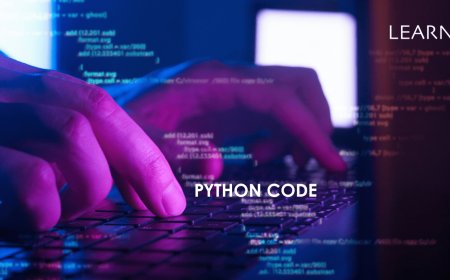Python is a popular programming language because it's easy to learn and can do a lot of different things. It's used by both beginners and experts to make all sorts of programs, from simple ones to complicated ones. But sometimes, as projects get bigger and more complicated, programmers run into problems that need some advanced knowledge of Python to solve. So, in this series called "Advanced Python Concepts," we're going to dive into the trickier parts of Python. We'll teach you stuff that will help you solve tough problems faster and better. This will make you a better Python programmer and open up new possibilities for what you can do with Python.
We'll cover things like fancy ways to organize data, smart tricks for handling really big projects, and ways to make your programs run faster by doing multiple things at once. Whether you're already pretty good at Python and want to get even better, or you're just starting and want to learn some cool new stuff, this series is for you.
Exploring Python: A Simple Guide to Functions and Modules
Python is a popular programming language known for its simplicity and power. At the heart of Python are two important concepts: functions and modules. we'll dive into these concepts in an easy-to-understand way, helping you become skilled in Python programming.
I. Functions in Python:
Functions in Python are like mini-programs that do specific tasks. They help make our code reusable and easy to manage. Let's look at the main parts of functions:
1. Syntax:
def function_name(parameters):
"""docstring"""
# function body
return [expression]
To create a function, you use the `def` keyword followed by the function name and any parameters it needs. The function body contains the code to be executed.
2. Parameters and Arguments:
Parameters are like placeholders in a function, while arguments are the actual values we give the function to work with. There are different types of parameters, like ones you specify by position, by keyword, with default values, or with variable lengths.
3. Return Statement:
Functions can give back a result using the `return` keyword. They can return one value or multiple values packed into a tuple.
4. Scope:
Variables inside a function have a local scope, meaning they only exist within that function. You can use the `global` keyword to access variables from outside the function.
5. Lambda Functions:
These are small, anonymous functions created with the `lambda` keyword. They're handy for simple tasks and can be written in one line.
6. Decorators:
Decorators are functions that change the behavior of other functions. They're marked with the `@` symbol and are used to enhance or modify the functionality of functions.
7. Recursion:
This is when a function calls itself. It's useful for solving certain types of problems but needs a base case to avoid endless looping.
II. Modules in Python:
Modules are like toolkits containing code we can reuse in our programs. They help organize our code and make it easier to manage. Let's take a closer look:
1. Creating Modules:
-
Simply save Python code in a `.py` file.
-
Import modules using the `import` statement.
2. Module Search Path:
-
Python searches for modules in directories specified by the `sys. path` list.
-
Additional directories can be added using the `PYTHONPATH` environment variable.
3. Package:
-
A directory containing an `__init__.py` file and other modules.
-
Allows hierarchical organization of modules.
4. Importing:
-
`import module_name`
-
`from module_name import function_name`
-
`import module_name as alias`
5. Built-in Modules:
-
Python comes with a standard library of modules for various purposes.
-
Examples: `math`, `random`, `datetime`, `os`, `sys`, etc.
III. Advanced Python Concepts:
Python has some advanced features that let us do even cooler things with functions and modules:
1. Function Annotations: These let you add extra information about the types of parameters and return values a function expects and produces.
2. Generator Functions: These are special functions that can pause and resume their execution, allowing for more memory-efficient processing of large datasets.
3. Closures: These are functions that remember the environment in which they were created, allowing them to maintain a state between calls.
4. `__name__` Attribute: This is a special attribute that tells you the name of the current module. It's often used to check if a module is being run as a standalone program or imported into another module.
Understanding Object-Oriented Programming (OOP) in Python: Exploring Python's Cool Stuff
Python is a cool programming language that's known for being easy to read and use. One of the coolest things about Python is its support for something called Object-Oriented Programming, or OOP for short. OOP helps organize our code better and makes it easier to reuse and maintain. In this blog, we'll take a closer look at Object-Oriented Programming in Python, starting from the basics and going into some cool advanced stuff.
1. Encapsulation:
Encapsulation is a fancy word for putting together data and the actions you can do with that data into one package. We call this package a "class" in Python. Let me show you a simple example:
class Car:
def __init__(self, make, model):
self.make = make
self.model = model
def display_info(self):
print(f"This car is a {self.make} {self.model}.")
# Let's create a car object
my_car = Car("Toyota", "Corolla")
my_car.display_info()
Here, `Car` is a class that bundles together information about a car, like its make and model, along with a method to display that information.
2. Inheritance:
Inheritance is like passing down traits from one class to another. Imagine if a new class could inherit all the good stuff from an existing class. That's what happens in Python with inheritance. Check it out:
class ElectricCar(Car): # ElectricCar inherits from Car
def __init__(self, make, model, battery_capacity):
super().__init__(make, model)
self.battery_capacity = battery_capacity
def display_info(self): # We can even change how methods work!
print(f"This electric car is a {self.make} {self.model} with a battery capacity of {self.battery_capacity} kWh.")
# Let's create an electric car object
my_electric_car = ElectricCar("Tesla", "Model S", 100)
my_electric_car.display_info()
Here, `ElectricCar` is a class that inherits from `Car`, so it gets all the cool stuff from `Car`, plus some extra stuff like battery capacity.
3. Polymorphism:
Polymorphism is a fancy word that means different things can be treated in the same way. In Python, this means we can use different types of objects interchangeably. Let me show you:
class Shape:
def area(self):
pass
class Circle(Shape):
def __init__(self, radius):
self.radius = radius
def area(self):
return 3.14 * self.radius ** 2
class Rectangle(Shape):
def __init__(self, width, height):
self.width = width
self.height = height
def area(self):
return self.width * self.height
# We can treat circles and rectangles in the same way!
def calculate_area(shape):
return shape.area()
# Let's create some shapes and calculate their areas
circle = Circle(5)
rectangle = Rectangle(4, 6)
# Now we can calculate their areas using the same function
print("Circle Area:", calculate_area(circle))
print("Rectangle Area:", calculate_area(rectangle))
In this example, `calculate_area` can work with both circles and rectangles because they both have an `area` method.
4. Advanced Python Concepts in OOP:
In addition to the basics, Python offers some advanced features for OOP:
1. Abstract Base Classes (ABCs): These are special classes in Python that are meant to be built upon. They help enforce rules for how other classes should be structured.
2. Decorators: Decorators are like little helpers that can modify how functions or methods work. They're often used to add extra functionality to code without changing it too much.
3. Mixins: Mixins are like reusable code snippets that can be added to different classes. They're a clever way to share code between classes without repeating yourself.
Mastering Exception Handling in Python: A Comprehensive Guide
Dealing with errors is a big deal in programming, especially in Python. It helps programmers deal with problems that might pop up while running a program. In Python, when something goes wrong, it raises what's called an "exception," and we can handle these exceptions in different ways. This blog will cover the basics of handling exceptions in Python, including what they are, how to deal with them, and some best practices.
1. Common Types of Exceptions in Python:
Python has different types of exceptions to handle different kinds of errors. Some common ones include:
-
ValueError: This happens when you give a function the right kind of data but with the wrong value.
-
TypeError: This occurs when you try to do something with a type of data that doesn't work.
-
FileNotFoundError: If you're looking for a file or directory that doesn't exist, you'll get this exception.
-
ZeroDivisionError: When you try to divide a number by zero, Python will raise this exception.
-
IndexError: If you try to access an item in a list or sequence that doesn't exist, you'll see this.
2. Try-Except Blocks:
One way to handle exceptions in Python is by using try-except blocks. Here's how it works:
try:
# Some code that might cause an exception
except ExceptionType:
# Code to handle the exception
In a try block, you put the code that might cause an exception. If an exception happens, Python looks for an except block that matches the type of exception. If it finds one, it runs the code inside that except block to deal with the problem.
3. Exception Hierarchy:
Python organizes its exceptions in a hierarchy, like a family tree. At the top is a general class called `Exception`, and there are more specific classes below it. This helps us handle different types of exceptions more precisely.
4. Best Practices for Exception Handling:
When it comes to handling exceptions in Python, here are some tips to keep in mind:
- Be specific: Only catch the exceptions you expect and handle them in the right way.
- Use multiple except blocks: Handle different types of exceptions separately so you can give better error messages and fix problems more effectively.
- Avoid catching everything: Don't catch every possible exception, as it can make debugging harder.
- Log exceptions: Keep track of exceptions in a log to help with troubleshooting.
- Use final block: Use a final block to run cleanup code that should happen no matter what.
Understanding Working with Files in Python
Python is a powerful programming language that can do many things. One important thing it can do is work with files on your computer. In this tutorial, we'll learn about working with files in Python. We'll cover the basics, like how to open, read, write, and close files.
1. Opening a File:
-
To start working with a file in Python, you use the `open()` function.
-
Here's how you use it: `file_object = open("filename", "mode")`
-
There are different modes you can open a file in, like "read," "write," or "append."
For example:
`file = open("example.txt", "r")`2. Reading from a File:
-
Once you've opened a file, you can read its contents.
-
You can use methods like `read()`, `readline()`, or `readlines()` for reading.
-
`read()` reads the whole file as one string, `readline()` reads one line at a time, and `readlines()` reads all lines into a list.
For example:
file = open("example.txt", "r")
content = file.read()
print(content)
3. Writing to a File:
-
If you want to write to a file, you need to open it in write or append mode.
-
Then, you can use the `write()` method.
For example:
file = open("example.txt", "w")
file.write("Hello, World!")
file.close()
4. Closing a File:
-
It's important to close a file after you're done working with it.
-
You can do this using the `close()` method.
For example:
file = open("example.txt", "r")
# Do some operations
file.close()
Learning advanced Python is like discovering a whole new world of cool stuff you can do with your code. You can get good at using fancy tools and techniques, like special ways of organizing data and solving complex problems. It might be tough at first, but it's worth it because you'll understand Python way better. Once you master these advanced skills, you can tackle tricky problems with confidence and write code that's cleaner and faster. Whether you want your programs to run quicker, handle lots of users, or just become a better coder, learning advanced Python is important.




































